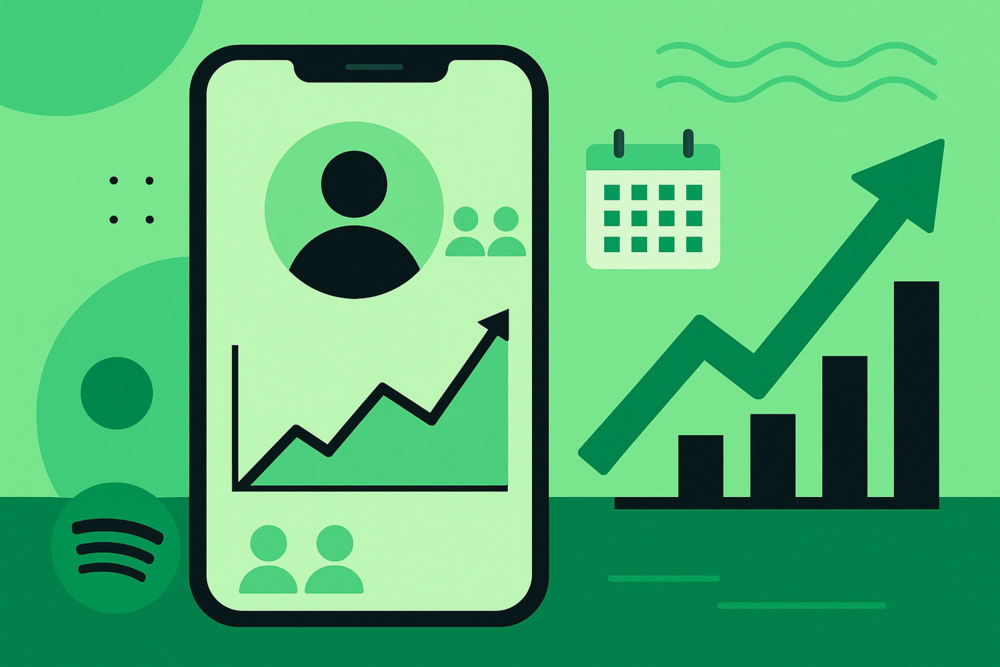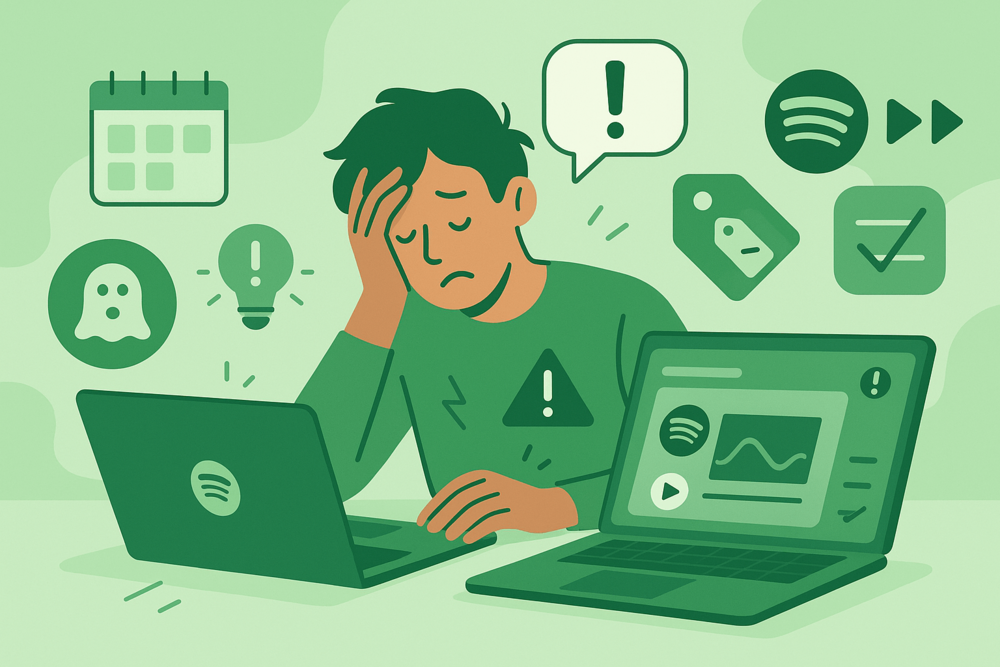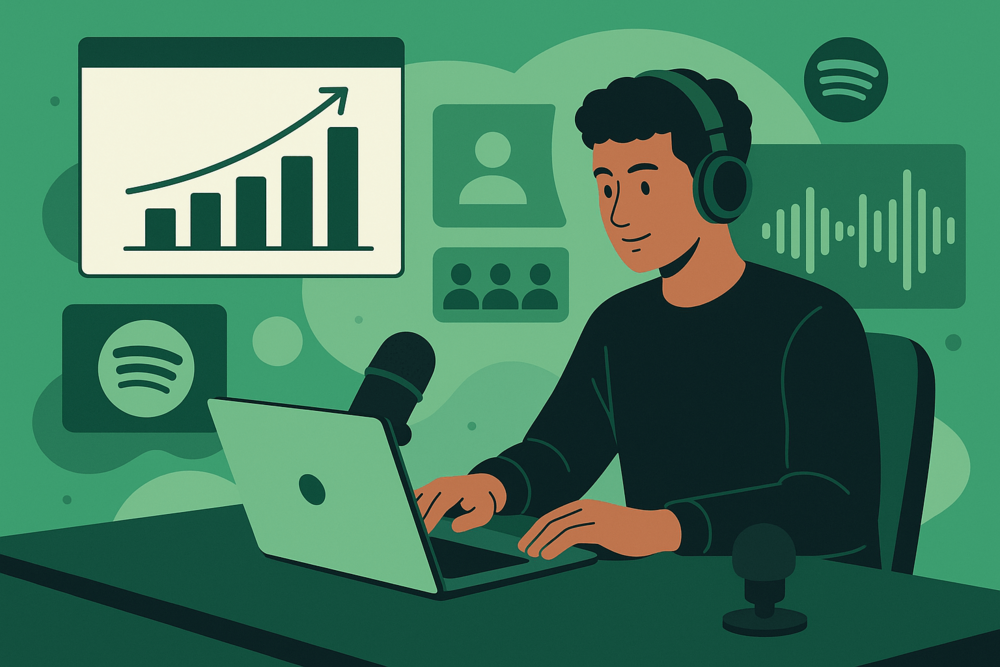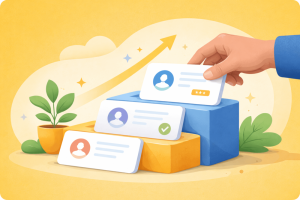Spotify has over 600 million users, but getting heard takes more than just uploading your music or podcast and hoping for the best.
If you want to grow your monthly listeners, you need real visibility, consistent output, and a plan that goes beyond simply hitting “publish.”
This isn’t about tricking the algorithm or chasing quick wins. It’s about understanding how Spotify works, showing up where it matters, and giving people a reason to keep coming back.
In this guide, you’ll find practical, proven ways to grow your audience. No fluff, no gimmicks. Just the steps that actually help musicians, podcasters, and creators build steady, meaningful growth.
What Counts as a Monthly Listener on Spotify?

If you’re trying to grow on Spotify, this number matters. But what does it actually mean?
It’s not about total streams
Monthly listeners aren’t people who play your music over and over.
This stat counts how many individual people have played at least one of your tracks or episodes in the past 28 days. One stream from one person is enough to count.
The number updates daily
Spotify refreshes this stat every day, looking at activity from the last 28 days.
So if your plays slow down or spike, you’ll see it reflected almost immediately.
To keep it moving up, you need regular traffic and new listeners discovering you.
Why it’s important
Your monthly listener count is public. It shows up on your profile, and it’s one of the first signals people use to gauge your reach.
Whether it’s fans, playlist curators, or potential collaborators, this number gives a quick sense of momentum.
You’ll also see it inside Spotify for Artists, where it helps you track real progress.
Step 1: Optimize Your Spotify Profile
Before anyone hits play, they’ll usually check your profile. That quick scan can be the difference between gaining a listener or losing them.
Start with a clear profile photo and cover art that match your sound or theme. Then write a short, keyword-friendly bio that tells people who you are and what you make.
Also make sure to:
- Link to your social media and website
- Pin your best track or episode to the top
- Use Spotify Canvas to add short looping visuals to songs
A strong profile makes you look serious and ready for more listeners.
Step 2: Release Music or Episodes Consistently
Consistency helps both your fans and the Spotify algorithm remember you. Regular releases keep you in rotation and give new people more chances to find you.
Here’s how consistency plays out:
| What You Do | Why It Works |
| Release weekly or biweekly | Helps you show up in Release Radar and other feeds |
| Stick to a theme or series | Builds familiarity and gives fans a reason to return |
| Space out releases | Allows each drop to get proper attention |
Step 3: Submit to Editorial and Algorithmic Playlists
Spotify gives you tools to get noticed. Use Spotify for Artists to submit your music at least seven days before release.
You’ll get a shot at:
- Release Radar
- Discover Weekly
- Radio and Autoplay
To improve your chances, focus on making content that gets saved, shared, and played through to the end. Those signals help the algorithm know people actually like what they’re hearing.
Submitting takes minutes and can open big doors, so don’t skip it.
Step 4: Promote Your Spotify on Social Media
Most people won’t find you on Spotify first. They’ll find you on social media then head over to listen.
Here’s a simple strategy that works:
One clip, three platforms, five days of reach
- Post a short video to TikTok
- Recut it for Reels
- Share it again on YouTube Shorts
- Add a callout with your Spotify link
Don’t forget to update your bio links, use Highlights on Instagram, and team up with creators who already have the audience you’re looking for.
Step 5: Use Smart Spotify Growth Tools Like Bulkoid
If you’ve done the work and just need more people to hear it, a smart growth tool can help. Bulkoid gives you a head start by increasing real plays and followers.
It’s not about faking success. It’s about helping the right people notice you.
- Get early traction that helps trigger the algorithm
- Make your profile look active when it matters most
- Improve your chances with curators and potential collaborators
Real growth needs real content but a little visibility boost can go a long way when you’re starting out.
How to Grow a Podcast on Spotify

Spotify is one of the top platforms for podcast growth, but standing out takes more than just uploading episodes. Here’s how to build your audience and keep them coming back.
Use strong titles and descriptions
Your title is the first thing people see, so make it clear and engaging.
Think about what would make someone stop scrolling and hit play. Avoid vague wording and try to include a keyword or two when it fits naturally.
Descriptions help Spotify understand your content. Use them to explain what the episode is about and why it’s worth listening to.
Create a short trailer episode
New listeners won’t always jump into a full hour.
A trailer gives them a quick taste of what your podcast is about. Keep it under two minutes, and pin it to the top of your feed so it’s easy to find.
Ask for follows and ratings
A quick reminder at the end of your episodes can go a long way. Ask listeners to follow your show and leave a rating if they enjoyed it. Keep it short, friendly, and consistent.
Turn long episodes into short clips
Pull out strong moments, quotes, or takeaways from each episode and turn them into short videos.
Add captions, a hook, and a call to action like “Listen to the full episode on Spotify.”
You can post these clips on:
- TikTok
- Instagram Reels
- YouTube Shorts
This brings in listeners who might not find you through the app alone.
Promote across your channels
Don’t rely on Spotify alone.
Share new episodes in your newsletter, feature them in blog posts, and post about them on your socials. You can also mention your show when guesting on other podcasts.
The more places you show up, the easier it becomes for new listeners to discover you.
How to Track Your Progress

Spotify gives you built-in tools to help track your audience.
Whether you’re a musician or a podcaster, you’ll want to check your stats regularly to understand what’s actually moving the needle.
You’ll find everything you need inside Spotify for Artists or Spotify for Podcasters, depending on your content.
Both dashboards show how your audience is growing over time and how they’re interacting with your releases.
Keep an eye on:
- Monthly listeners – your reach across the last 28 days
- Follower growth – how many people choose to stay connected
- Skips, saves, and completions – strong signals of how engaging your content is
Another metric worth watching is playlist activity. If a track or episode is getting added to listener playlists or showing up on algorithmic ones, that’s a sign your content is resonating.
💡 Tip: Use UTM links when promoting your content off-platform. This helps you see exactly which post, platform, or story drove people to your Spotify page.
Common Mistakes to Avoid

You can have great content and still struggle to grow if you’re unknowingly holding yourself back. These are some of the most common mistakes people make on Spotify, along with simple ways to fix them.
Posting once, then going silent
Dropping a single episode or track and disappearing sends the wrong message to both the algorithm and your audience.
Inconsistent posting causes you to lose momentum and makes it harder for listeners to stay engaged.
How to fix it:
Build a content schedule that works for you. Even one release every two or three weeks is better than long gaps with no updates.
Try batching content ahead of time so you always have something in the queue.
Paying for fake streams
It might look like quick growth, but fake plays can hurt you. Spotify tracks suspicious activity, and if your streams don’t look legit, your content could be removed or flagged.
How to fix it:
Focus on tools that help build real engagement.
Services like Bulkoid work by boosting your visibility through real listeners, not bots. Steady, authentic growth always leads to better results in the long run.
Skipping metadata and upload details
Metadata might seem boring, but it plays a big role in discovery.
If your track or episode doesn’t have the right tags, genre info, or artist credits, Spotify can’t recommend it properly.
How to fix it:
Take a few extra minutes before publishing to double-check everything.
Add accurate titles, choose the correct genre, and include relevant contributors. These small details help you show up in the right places.
Not promoting your content outside Spotify
If you’re only relying on Spotify to grow your audience, you’re missing out. Most people won’t find you through the app unless you guide them there.
How to fix it:
Talk about your releases on social media, in newsletters, or anywhere your audience already spends time.
Use video clips, quotes, or trailers to spark interest, then link to the full content on Spotify. The more entry points you create, the more chances people have to find you.
Summary: Your Spotify Growth Starts With Visibility

Growing your monthly listeners on Spotify isn’t about luck.
It’s about showing up consistently, creating content people want to come back to, and making sure that content gets seen.
You don’t need to be a viral star overnight. Focus on the basics:
- Optimize your profile
- Release content regularly
- Submit to playlists early
- Promote off-platform
- Track what works and what doesn’t
- Avoid shortcuts that hurt your growth
If you’re putting in the work but not getting enough visibility, that’s where Bulkoid can help. It’s built to boost your real plays and followers, giving your content the momentum it needs to break through.
👉 Ready to grow your Spotify presence the smart way?
Use Bulkoid to reach more listeners, get on the algorithm’s radar, and start building a real audience that sticks around.
























